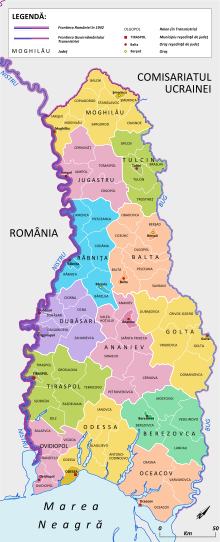| Transnistria Governorate Guvernământul Transnistriei | |||||||||||||||
|---|---|---|---|---|---|---|---|---|---|---|---|---|---|---|---|
| Governorate of Romania | |||||||||||||||
| 1941–1944 | |||||||||||||||
 Administrative map of the Transnistria Governorate | |||||||||||||||
| Capital | Odesa | ||||||||||||||
| Area | |||||||||||||||
| 39,733 km2 (15,341 sq mi) | |||||||||||||||
| Population | |||||||||||||||
| 2,326,226 | |||||||||||||||
| Government | |||||||||||||||
| • Type | Military–civilian administration | ||||||||||||||
| Governor | |||||||||||||||
• 1941–1944 | Gheorghe Alexianu | ||||||||||||||
• 1944 | Gheorghe Potopeanu | ||||||||||||||
| Historical era | World War II | ||||||||||||||
• Established | 19 August 1941 | ||||||||||||||
• Disestablished | 1 April 1944 | ||||||||||||||
| |||||||||||||||
| Today part of | Moldova (Transnistria) Ukraine | ||||||||||||||
The Transnistria Governorate (Romanian: Guvernământul Transnistriei) was a Romanian-administered territory between the Dniester and Southern Bug, conquered by the Axis Powers from the Soviet Union during Operation Barbarossa. A Romanian civilian administration governed the territory from 19 August 1941 to 29 January 1944. A brief military administration followed, during which the Romanians withdrew from the region by late March 1944. German control became official on 1 April 1944.
Limited in the west by the Dniester river (separating it from Bessarabia), in the east by the Southern Bug river (separating it from the German Reichskommissariat Ukraine), and in the south by the Black Sea, it comprised the present-day region of Transnistria (which compared to the World War II whole is only a small strip along the bank of the Dniester) and territories further east (modern Odesa Oblast eastward of the Dniester, southern Vinnytsia Oblast and a small part of Mykolaiv Oblast), including the Black Sea port of Odesa, which became the administrative capital of Transnistria during World War II.
In World War II, the Kingdom of Romania, persuaded and aided by Nazi Germany, took control of Transnistria for the first time in history. In August 1941, Adolf Hitler persuaded Ion Antonescu to take control of the territory as a substitute for Northern Transylvania, occupied by Miklós Horthy's Hungary following the Second Vienna Award. Despite the Romanian administration, the Kingdom of Romania did not formally incorporate Transnistria into its administrative framework; the Nazi-friendly Antonescu government hoped to annex the territory eventually, but developments on the Eastern Front precluded it.[3]
- ^ Stancu, Vasile (2012). "O pagină uitată din Istoria Românilor Administrația civilă românească din Transnistria, în timpul celui de-al II-lea război mondial (I)". No. 242. condeiulardelean.ro. Archived from the original on 19 April 2021. Retrieved 19 April 2021.
- ^ "Transnistria Then and Now". romaniancoins.org. Retrieved 19 April 2021.
- ^ (in Romanian) Ottmar Trașcă, Ocuparea orașului Odessa..., "George Barițiu" Institute of History's Annual, Series Historica , 2008.

